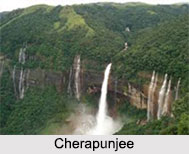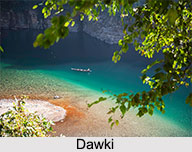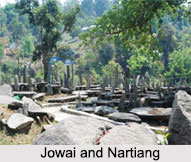 Meghalaya are interspersed with hills making the city "the land of rain clouds", in the literal sense of the term. Cities of Meghalaya are covered with subtropical forests that are the genuine habitat of a wide variety of flora and fauna. The chief tribal residences in the cities are the Jaintias, the Khasis and the Garos.
Meghalaya are interspersed with hills making the city "the land of rain clouds", in the literal sense of the term. Cities of Meghalaya are covered with subtropical forests that are the genuine habitat of a wide variety of flora and fauna. The chief tribal residences in the cities are the Jaintias, the Khasis and the Garos.
One of the unique features of all the cities of Meghalaya is that a majority of the tribal population follows a matrilineal system where lineage and birthright are traced through women.
 The waters of numerous rivers like the Daring River, Sanda River, Bandra River, Bhogai River, Mawpa River, Umiew River and many others rinse the cities. The deep gorges and beautiful waterfalls created by these rivers enhance the heavenly beauty of the place, and attract lots of tourists. The main Cities of Meghalaya are Shillong (the capital city), Baghmara, Cherrapunjee and Tura.
The waters of numerous rivers like the Daring River, Sanda River, Bandra River, Bhogai River, Mawpa River, Umiew River and many others rinse the cities. The deep gorges and beautiful waterfalls created by these rivers enhance the heavenly beauty of the place, and attract lots of tourists. The main Cities of Meghalaya are Shillong (the capital city), Baghmara, Cherrapunjee and Tura.
Shillong
The hill town of Shillong in Meghalaya is situated at an altitude of 1496 m above sea level. Shillong remained the capital of Assam, before the formation of Meghalaya in the 1974. The place, the people and the climate all wrapped together create an amiable atmosphere, to make Shillong an ideal holiday destination throughout the year.
Baghmara
Baghmara is the headquarters of South Garo Hills district in the state of Meghalaya. The place is bordered by Bangladesh and is about 113 km from Tura. It is covered with lush hills and has a river flowing through its expanse.
Cherrapunjee
 Cherrapunjee was once known to be the wettest land on earth. Beautiful waterfalls are the most capturing natural magnificence.
Cherrapunjee was once known to be the wettest land on earth. Beautiful waterfalls are the most capturing natural magnificence.
Tura
Tura in Meghalaya is famous for its picture postcard beauty. This little town situated in the Garo Hills, boasts of a wonderful landscape of lofty hills, against a backdrop of low-lying plains, with the mighty Brahmaputra River, dramatically rushing through, towards Bangladesh.
Dawki
Ninety-six kilometres southeast from Shillong, Dawki is the most important of the Maghalaya-Bagladesh border crossings and has excellant views of the Khasi Hills and Bangladesh.
Jowai and Nartiang
The market town of Jowai 64km northeast of Shillong in the Jaintia Hills holds the annual Behdienkhlam festival every July. About 12 km north of the town, at Nartiang are the remains of the Jaintia kings summer palace and an impressive collection of monoliths and standing stones.
Mawphlang
 Its vast floral wealth makes Mawphlang a great attraction for nature lovers. Its orchids are out of this world. You can also enjoy the hot springs at Jakrem. The Bangladesh border is very close to Dawki a popplar picnic spot.
Its vast floral wealth makes Mawphlang a great attraction for nature lovers. Its orchids are out of this world. You can also enjoy the hot springs at Jakrem. The Bangladesh border is very close to Dawki a popplar picnic spot.
Mairang
Mairang is a town and a town area committee in West Khasi Hills district in the Indian state of Meghalaya.
Nongstoin
Nongstoin is the headquarters of West Khasi Hills district in the state of Meghalaya in India.
Balat
Balat is a town in the Indian state of Meghalaya. The climate here is tropical. During most months of the year, there is significant rainfall in Balat.



















